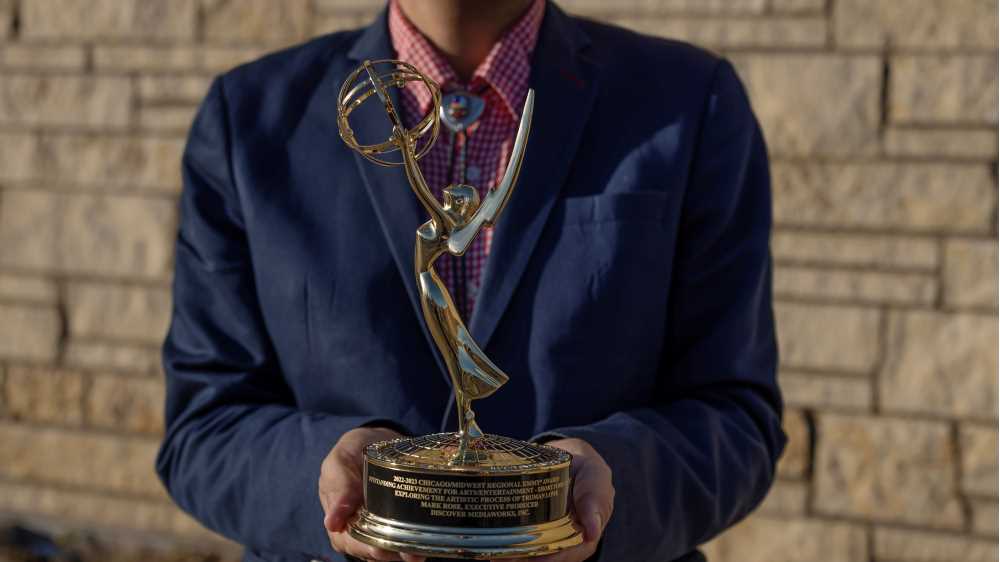A documentary covering the art and life of Truman Lowe, Ho-Chunk artist and UWL alum, ‘69, has been awarded a regional Emmy.
“Exploring the Artistic Process of Truman Lowe: A Journey Through Native American Art & Education” by Discover Wisconsin premiered on April 19. The documentary features Lowe’s artistic achievements and teaching legacy and includes UWL unveiling the renamed “Truman T. Lowe Center for the Arts” in October 2022.
“It’s gratifying to know that there are people out there that admire Truman and the work he did so much that they wanted to make a documentary about him,” says Tonia Lowe, Truman’s daughter. “We were very supportive, but the real work was done by Casey Brown and Rob Reider of the Ho-Chunk Nation, the team at Discover Wisconsin, and Jo Ortel, art historian and author of ‘Woodland Reflections: The Art of Truman Lowe.’”

Tonia and her mother, Nancy, say that the documentary winning an Emmy was the best kind of surprise. They love the documentary, reminding them of Truman’s quiet wisdom and ability to inspire people to think about the environment differently. The award is the icing on the cake.
“It’s been very well received, especially by the Ho-Chunk Nation where it’s a tremendous point of pride, not just winning the Emmy, but to have a Ho-Chunk artist celebrated,” says Brett Rolstad, producer, director and writer for Discover Mediaworks. “Truman’s art was centered around and inspired by their culture and history. Truman touched and influenced a great number of lives, and the recognition of that is very important.”
Rolstad explains creating the film posthumously was a slight challenge. Lowe, who died in 2019, was a public figure, but many describe him as a very reserved and private person.
“I always wanted to include his voice as the central narrative, but finding interviews and footage was a bit of a challenge,” Rolstad says. “However, working in Wisconsin is also just amazing. Everyone is so accommodating and helpful, from UW-La Crosse to Truman’s wife (Nancy), everyone was extremely willing to lend a hand. It was an amazing experience.”
The documentary, just over six minutes long, covers Lowe’s initial draw to the arts, his artistic career achievements and contributions, his impactful teaching, and the role he played as an advocate for Native artists and students.

“The most challenging aspect of the project for me was trying to figure out how to talk about the significance of Truman’s art and life as accurately and succinctly as I could,” says Jo Ortel, a professor emerita of art history at Beloit College and good friend of Lowe’s.
Another aspect highlighted in the film is the renaming ceremony of the UWL fine arts building in honor of Lowe.
“Since the filmmakers also planned to feature La Crosse’s newly renamed Truman T. Lowe Fine Arts Center in the documentary, I wanted to make sure there was no misapprehension about how that renaming came about,” says Ortel. “Chancellor Gow and the University deserve to be celebrated for taking such a bold and consequential step. In a world in which buildings and arenas are too often named after the highest bidders, UW-La Crosse signals that it defines success differently and welcomes and supports its indigenous students.”
Casey Brown, contributor to the film and member of the Ho-Chunk Nation, is one example of an individual greatly impacted by Lowe.
“To be able to further his legacy means a lot,” says Brown. “To see people from across the board — Ho-Chunk, non-Ho-Chunk or non-native folks — learning about this individual that did remarkable work, is also Ho-Chunk and from a small town in Wisconsin really touches folks.”
Rolstad says that sharing this documentary with the world has shown him how much of an audience there is for it.

“I think I’ve seen a lot of those ‘ah-ha’ type of moments while working with the Ho-Chunk, that their culture is really fascinating and something truly unique and special, and to be cherished,” Rolstad says. “Sometimes that can be lost when you are so close to it and it’s just part of your life. But when you see the recognition by hundreds of thousands of people, it can shed new light on just how special or important that really is.”
Brown says he was overwhelmed and elated after walking across the stage with an Emmy. Later, he visited UWL to share the Emmy with students, faculty and staff.
“As a kid from Black River Falls, that was not on the list of things you’d do and achieve. But that’s part of it — the inspiration from Truman allows those like me to get out there, do those things and put yourself in those places,” Brown says. “Obviously, I wanted to take the Emmy back to La Crosse, ultimately where the inspiration for the video came from.”
“Exploring the Artistic Process of Truman Lowe: A Journey Through Native American Art & Education” is part of an ongoing series with the Ho-Chunk Nation and Discover Wisconsin. It can be found on the Discover Wisconsin YouTube page.
Written by UW-La Crosse
Link to original story: https://www.uwlax.edu/news/posts/regionally-recognized/

